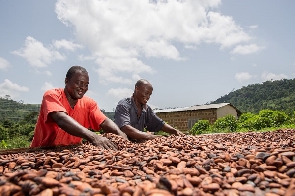 Cocoa is trading at a premium on international commodity markets
Cocoa is trading at a premium on international commodity markets
Cocoa is trading at a premium on international commodity markets for fear that there may be shortages of the commodity, ahead of the approaching implementation of the Living Income Differential (LID) later this year.
The International Cocoa Organization (ICO) in its latest report indicates that traders have now adopted a backwardation of futures contract, which has led to higher demand for the commodity on the spot market currently than for the contracts maturing in the coming months through the futures market. Ghana sells its cocoa on the futures market in order to secure financing from an international syndication of banks for the purchase of cocoa from local producers.
“The March contract was trading with a premium over deferred contracts to attract additional volumes of cocoa warrants. The backwardation of futures contracts close to expiry is now a recurrent feature of both the London and New York futures markets,” the ICO stated in its March 2020 report.
The progressive withdrawal of Ivorian and Ghanaian beans from the markets as a result of the implementation of LID is accounting for the beans to be currently trading at a premium.
“…this is the direct result of the progressive withdrawal of Ivorian and Ghanaian beans from exchange certified stocks in anticipation of the Living Income Differential (LID) which will start at the beginning of the 2020 /21 season,” the report explained.
Moreover, starting from 11 March, the differential between the New York and the London markets started to decline as the March contract – which was in backwardation only in the New York market – approached its expiration on 16 March.
Currently, as at Thursday, April 30th, 2020, on the International Commodities Exchange Futures segment of the New York market, Cocoa Futures for July 2020 contracts are trading at US$2,409.00 metric tonnes, whereas for the London market, cocoa futures for May and July 2020 contracts are trading at US$ 1988.00 per metric tonnes and US$ 1915.00 per metric tonnes, respectively.
Cocoa Production and Prices Projections
In January 2020, a Reuters poll of nine traders and analysts showed that London cocoa futures will fall six percent by the end of the year, weakened by the prospect of rising production in Ivory Coast and Ghana. However, prices should still post an annual gain following a sharp rise this month.
London prices were seen ending 2020 at 1,850 pounds a tonne, but will still reman four percent higher than the market close at the end of last year.
Nevertheless, ending last year, Regulators of the cocoa industry in both Ghana and Ivory Coast initiated efforts to introduce a cocoa production ceiling to firm up global market prices by preventing overproduction
This is to address the concerns of cocoa buyers of possible excess production by cocoa farmers in both countries, inspired by the fixed “living income differential” (LID), but which would ultimately lead to lower prices if supply significantly exceeds demand.
Prior to the plans to introduce a production ceiling, the two nations, who produce two-thirds of the world’s cocoa, imposed a fixed “living Income differential (LID)” or premium of US$ 400 a tonne in July 2019 on all cocoa sales starting from the 2020/21 season.